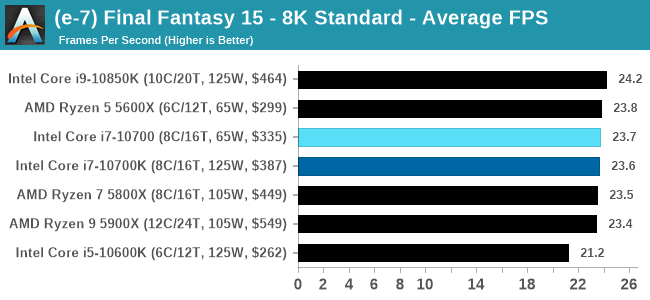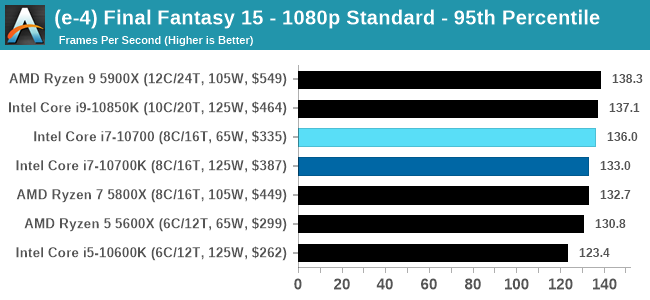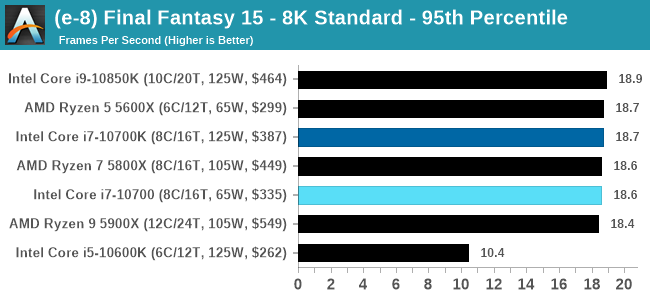Intel Core i7-10700 vs Core i7-10700K Review: Is 65W Comet Lake an Option?
by Dr. Ian Cutress on January 21, 2021 10:30 AM EST- Posted in
- CPUs
- Intel
- Core i7
- Z490
- 10th Gen Core
- Comet Lake
- i7-10700K
- i7-10700
Gaming Tests: Final Fantasy XV
Upon arriving to PC, Final Fantasy XV: Windows Edition was given a graphical overhaul as it was ported over from console. As a fantasy RPG with a long history, the fruits of Square-Enix’s successful partnership with NVIDIA are on display. The game uses the internal Luminous Engine, and as with other Final Fantasy games, pushes the imagination of what we can do with the hardware underneath us. To that end, FFXV was one of the first games to promote the use of ‘video game landscape photography’, due in part to the extensive detail even at long range but also with the integration of NVIDIA’s Ansel software, that allowed for super-resolution imagery and post-processing effects to be applied.
In preparation for the launch of the game, Square Enix opted to release a standalone benchmark. Using the Final Fantasy XV standalone benchmark gives us a lengthy standardized sequence to record, although it should be noted that its heavy use of NVIDIA technology means that the Maximum setting has problems - it renders items off screen. To get around this, we use the standard preset which does not have these issues. We use the following settings:
- 720p Standard, 1080p Standard, 4K Standard, 8K Standard
For automation, the title accepts command line inputs for both resolution and settings, and then auto-quits when finished. As with the other benchmarks, we do as many runs until 10 minutes per resolution/setting combination has passed, and then take averages. Realistically, because of the length of this test, this equates to two runs per setting.
| AnandTech | Low Resolution Low Quality |
Medium Resolution Low Quality |
High Resolution Low Quality |
Medium Resolution Max Quality |
| Average FPS |  |
 |
 |
 |
| 95th Percentile |  |
 |
 |
 |
All of our benchmark results can also be found in our benchmark engine, Bench.












210 Comments
View All Comments
Samus - Friday, January 22, 2021 - link
I don't think ANYONE actually wants to see the numbers for these chips at 65W :)Spunjji - Monday, January 25, 2021 - link
I love a good laugh!iAPX - Saturday, January 23, 2021 - link
I totally agree, a 5600X and a 10700 on their 65W TDP, and their maximum performance, to gives a baseline of what performance-level is WARRANTED by their makers.etal2 - Thursday, January 21, 2021 - link
Setting the limits in the bios is very nice and all but without the voltage regulation and thermal capacity they can not sustain this performance for very long regardless of the numbers set.I very much doubt that on the 60$ cheap 4 phase vrm boards the manufacturers set the limits very high, they will get fried boards within the warranty period and we know very well they can't have that.
Spunjji - Friday, January 22, 2021 - link
That would be nice to see. Perhaps an article showing which of a representative selection of processors provide the best performance at a given set of fairly common power levels (65W / 95W / 125W).Something for when Dr Cutress finds himself with infinite time and no impending deadlines 😅
u.of.ipod - Thursday, January 21, 2021 - link
So happy I waited patiently and got a Ryzen 5600x for my small form factor system. The fact it can hang with the i7's and only consumes 1/3 the peak power draw is great for heat output and playing nicely with SFX PSUs.Golgatha777 - Thursday, January 21, 2021 - link
And that's how you end up with graphs like this one.https://cdn.mos.cms.futurecdn.net/i9W8M8HgGaTqRs4b...
Spunjji - Friday, January 22, 2021 - link
Oof.Samus - Friday, January 22, 2021 - link
Oof.magreen - Friday, January 22, 2021 - link
Pentium 4 Extreme Edition all over again